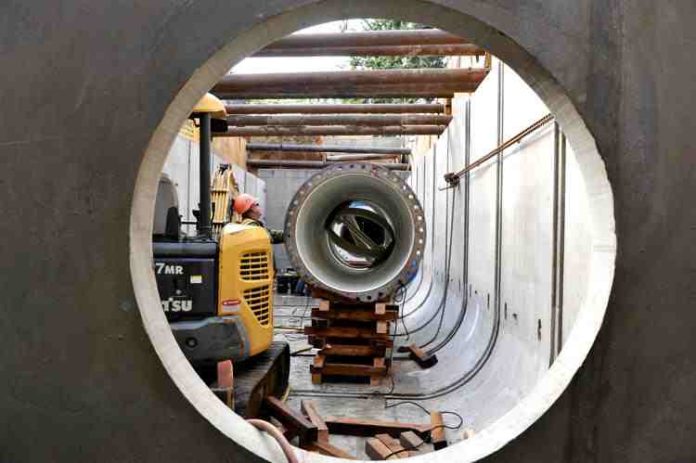
Electricity, power, juice… for decades we have seemingly been wobbling on the rope bridge between power generation and power consumption. More and more is demanded as technology multiplies, while at the same time, the current ways we generate electricity are chastised. Fossil fuels like coal and oil are killing us in a mass accounting of ways. Natural gas is cleaner and more efficient, but at what cost? The fracturing techniques that retrieve it are already being linked to earthquakes and other anomalies in areas they’ve never existed in. Solar works well in certain areas but not in others. Nuclear plants just scare the pants off of people and all of the above just seem to be unaffordable, gargantuan tasks with no immediate return.
Lucid Energy, located in Portland, Oregon, was formed in 2007 with the mission of creating a new way for towns and industries to turn the untapped potential of moving water into renewable energy. After 3 years of testing in southern California, they have now signed a contract with the city of Portland in what could be a giant step in the direction of clean energy. A giant project? No, but it is a giant idea. Lucid is installing small, pipe-mounted electric generating turbines inside the water lines that feed the city. I use the word small because when most people hear ‘hydroelectric’ or ‘water turbine’ they immediately think Hoover Dam, Niagara Falls and turbines that are bigger than a dump truck. Lucid’s ‘Lucidpipe’ units are designed to take the place of valves that reduce the water pressure in the feed lines to the city. Before we get too far ahead let’s iron out a few details. First, Portland and other cities like it have an even bigger incentive for a project like this because their water is gravity fed from a watershed in the mountains outside of the city. Most of the city’s water pressure simply comes from gravity pulling the water downhill. They are already saving money on electricity by not having to use motorized pumps. Second, these turbines will only be installed on piping larger than 16 inches in diameter, but are designed to be fit into lines as large as 96 inches (8 feet) in diameter. Why? Because there is always water moving through these large pipes… 24 hours a day, 7 days a week.
As for the history, the first functional prototype was installed inside a 42-inch water pipe in Riverside, California, in February 2010. The third generation of this system was installed and brought online in March of 2011, and in the following seven months, the unit generated more than 23 megawatt hours of renewable electricity… as a byproduct of the already flowing water. Obviously happy with the results, Riverside commissioned the install of a permanent unit in November of 2011 and it is still chugging along today. The unit being installed in Portland is predicted to produce right around 1100 Megawatts per year, which is enough power to continuously run about 150 homes. Take that big oil!
There’s the basic scoop. There is so much more to it than I can put in a simple article here, so if you’re curious about this undertaking I highly encourage you to search out and research it. It’s definitely worth the read.
SOURCES:
peters, adelle. (2015). Portland’s New Pipes Harvest Power From Drinking Water. Retrieved from http://www.fastcoexist.com/3041300/portlands-new-pipes-harvest-power-from-drinking-water
Portland’s Water System | The City of Portland, Oregon. (2015). Retrieved 24 February 2015, from https://www.portlandoregon.gov/water/48904
Riverside Public Utilities Wins AWWA Award for LucidPipeTM In-pipe Hydropower System. (2011). PRWEB. Retrieved from http://www.prweb.com/releases/2011/10/prweb8886576.htm
Xadmin. (2011, March). LucidPipeTM Power System. Retrieved 24 February 2015, from http://www.lucidenergy.com/lucid-pipe/
Citation
(peters, 2015)
(Xadmin, 2011)
(‘Riverside Public Utilities Wins AWWA Award for LucidPipeTM In-pipe Hydropower System’, 2011)
(‘Portland’s Water System | The City of Portland, Oregon’, 2015)






It’s good to be able to figure out how to exploit the water. Participated in a competition in Denmark in 2012. How I submitted the idea to exploit our sewers. For example, when rain water is running through the treatment plant . Also submitted the idea of leveraging our downspouts . But none of the proposed ideas were well-received . Congratulations on the new initiatives !
Don’t give up Simoen. You’re ideas are great. Thank you for them! Crowd sourcing? I understand the difficulty. We are fighting a wind turbine project in our town. These giant machines destroy the natural beauty of our landscape and are harmful to humans and wild life/ in our town they want to destroy acres of forest to build these things. And to add insult to injury-they produce a minimal amount of energy and are funded mainly through government tax dollars(they can’t make much money on their own-if any-the jury is still out. (a great project) We need great ideas like yours!Blind eyes/deaf ears
A bit sorry you didn’t mentions wind turbines in this article. I have been fighting a development in my town. A company wants to install 500 foot wind turbines in my town. Wind turbines are inconsistant requiring a gas or coal back up to run on stand-by causing more carbon emissions. They can also make people within a three mile radius sick from infra-sound. They destroy the natural beauty of the landscape and massacre bats, (barotrauma), and kill birds. I can only wonder what the off-shore ones,(LFN- low frequency sound travels further in water),are doing to our already threatened water wild-life and shore fisheries. Its great to hear about a renewable form of energy that really is renewable! We need more of this kind of science: great ideas- not great projects! Thank you for this information.